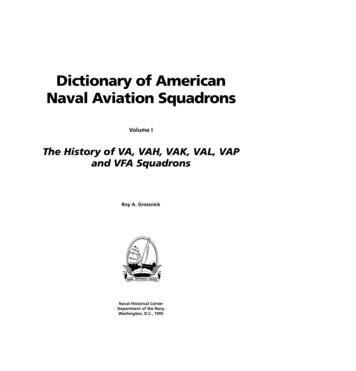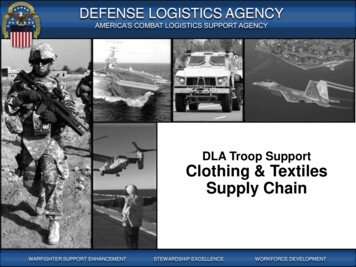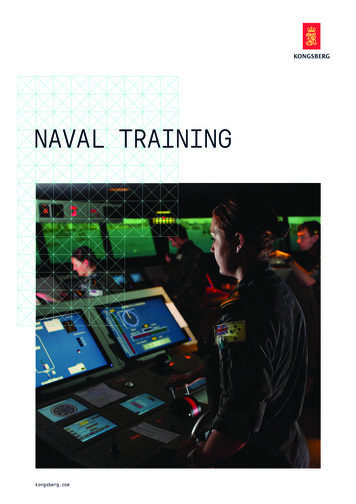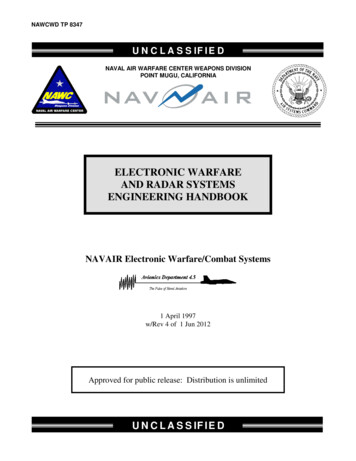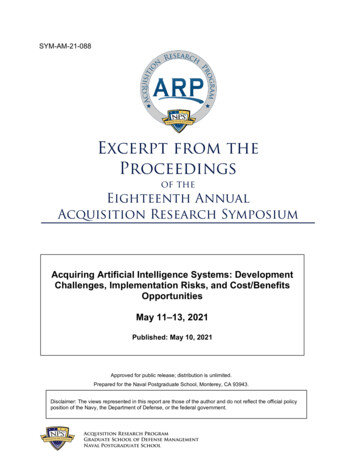
Transcription
SYM-AM-21-088Excerpt from theProceedingsof theEighteenth AnnualAcquisition Research SymposiumAcquiring Artificial Intelligence Systems: DevelopmentChallenges, Implementation Risks, and Cost/BenefitsOpportunitiesMay 11–13, 2021Published: May 10, 2021Approved for public release; distribution is unlimited.Prepared for the Naval Postgraduate School, Monterey, CA 93943.Disclaimer: The views represented in this report are those of the author and do not reflect the official policyposition of the Navy, the Department of Defense, or the federal government.Acquisition Research ProgramGraduate School of Defense ManagementNaval Postgraduate School
The research presented in this report was supported by the Acquisition ResearchProgram of the Graduate School of Defense Management at the Naval PostgraduateSchool.To request defense acquisition research, to become a research sponsor, or to printadditional copies of reports, please contact any of the staff listed on the AcquisitionResearch Program website (www.acquisitionresearch.net).Acquisition Research ProgramGraduate School of Defense ManagementNaval Postgraduate School
Acquiring Artificial Intelligence Systems: DevelopmentChallenges, Implementation Risks, and Cost/BenefitsOpportunities 1Thomas J. Housel, PhD—is a tenured, full professor for the Information Sciences (Systems) Departmentof the U.S. Naval Postgraduate School (NPS). He received his PhD from the University of Utah in 1980.He specializes in valuing intellectual capital, knowledge management, acquisitions research,telecommunications, information technology, value-based business process reengineering, andknowledge value measurement in profit and nonprofit organizations. He has managed a 5 millionportfolio of field studies, educational initiatives, and industry relationships. His current research focuseson determining the most promising methodologies for improving the acquisitions life cycle and developinga physics-based model to predict revenue growth in knowledge-intensive companies.Johnathan Mun, PhD—is a research professor at NPS and teaches master’s and doctoral courses aswell as executive seminars in quantitative risk analysis, decision sciences, real options, simulation,portfolio optimization, and other related concepts. Mun received his PhD in Finance and Economics fromLehigh University. He also has an MBA in business administration, an MS in management science, and aBS in Biology and Physics. He has taught at universities all over the world, is considered a leading worldexpert on risk analysis/real options analysis with more than 23 patents, and has authored more than 22books.Raymond D. Jones—is a Professor of the Practice in Acquisition Management at the Graduate School ofDefense Management at NPS. He retired as a Colonel from the U.S. Army in 2012 and his lastassignment in the Army was as the Deputy Program Executive Officer for the Joint Tactical Radio System(JTRS). He has a BS in Aerospace Engineering, an MS in Aeronautical Engineering from the NavalPostgraduate School, an MBA from Regis University, and an MA in National Resource Strategy from theIndustrial College of the Armed Forces. He is currently an IS PhD candidate at NPS.Timothy R. Shives, EdD—is a Department of Defense civil servant in the field of Information Technology(IT) management serving at the Defense Manpower Data Center. He is also an officer in the UnitedStates Marine Corps and has served more than 15 years in both the active duty and reserve components.He holds a Doctor of Education (EdD) and an Education Specialist (EdS) postgraduate degree, an MS inInformation Technology Management and an MBA from NPS, and an MA in National Security andStrategic Studies from the U.S. Naval War College, and is currently an IS PhD student at NPS.Benjamin Carlton, Major, USMC—is an active-duty Marine Officer currently serving as a project officerfor the Global Combat Support Systems-Marine Corps (GCSS-MC) at the Marine Corps SystemsCommand. Carlton contributed to this research while completing his studies for an MS in InformationTechnology Management at NPS, which he completed in 2020.Vladislav Skots, Major, USA—is an active-duty Army officer. Major Skots contributed to this researchwhile completing his studies for an MBA in Information Systems Technology at NPS, which he completedin 2019.AbstractThe acquisition of artificial intelligence (AI) systems is a relatively new challenge for the U.S.Department of Defense (DoD). Given the potential for high-risk failures of AI system acquisitions,it is critical for the acquisition community to examine new analytical and decision-makingapproaches to managing the acquisition of these systems in addition to the existing approaches(i.e., Earned Value Management). In addition, many of these systems reside in small start-up orrelatively immature system development companies, further clouding the acquisition process dueto their unique business processes when compared to the large defense contractors. This can lead1This ARP Conference Paper is an updated and abridged version of the full ARP Report NPS-PM-21-014,which is available at ion Research ProgramGraduate School of Defense ManagementNaval Postgraduate School- 333 -
to limited access to data, information, and processes that are required in the standard DoDacquisition approach. The well-known recurring problems in acquiring information technologyautomation within the DoD will likely be exacerbated in acquiring complex and risky AI systems.Therefore, more robust, agile, and analytically driven acquisition methodologies will be required tohelp avoid costly disasters in acquiring AI systems. This research provides a set of analytical toolsfor acquiring organically developed AI systems through a comparison and contrast of the proposedmethodologies that will demonstrate when and how each method can be applied to improve theacquisitions life cycle for AI systems.IntroductionThis report seeks to address the emerging field that falls under the umbrella term“Artificial Intelligence” or AI, and the Defense Acquisition System (DAS) that is not designed todevelop and procure such state-of-the-art, rapidly evolving AI technologies. Thus, the researchexamines the challenges of acquiring an AI-based system within the typical acquisitionsframework in business and in the Department of Defense (DoD) by conducting an analysis on aset of recommended quantitative tools for use in analyzing the processes in the acquisition oforganically developed DoD AI systems. Thus, this research introduces tried and truequantitative methods (EVM, KVA, IRM) for their application to the DoD Acquisition of AIsystems. Therefore, this research proposes the re-examination of acquisition methods,strategies, and methodologies based on the category of AI being acquired.Acquisitions of AI systems is a relatively new challenge for the DoD. Given the high riskof failure for such system acquisitions, it is critical that the acquisition community examinespotential new approaches to help manage the AI acquisition life cycle. The well-documentedrecurring problems in acquiring information technology within the DoD will likely be exacerbatedin acquiring these leading edge, complex, and risky systems. The identification, review, andrecommendation for the optimal use of new acquisition methodologies, to supplement or replaceexisting methodologies, should help avoid costly disasters in AI system acquisitions. In addition,the use of these methodologies should also create a more flexible acquisition scheme thatallows for incorporation of unanticipated, value added components of future AI systems. Pleasenote that this conference paper is an abridged version of the research conducted by Housel etal. (2020). For a more thorough discussion, see the full report of this research that provides arobust literature review, more detailed explanations, as well as the step-by-step process foreach of the three methodologies please see the full report. 2AI has been in use in various commercial and governmental domains to address avariety of decision support problems. However, existing DoD acquisition frameworks may not beadequate to address the unique nature of AI systems life-cycle investments. AI systems arequalitatively different than standard automation systems that focus on routine, repeatable tasks.To develop acquisition frameworks for AI systems, it is first necessary to examine how AIsystems will be used to support, or supplant, decision-makers. The purpose of this researchproject is to provide a set of quantitative and analytically robust decision-making methodologiesfor acquiring AI systems that address the inadequacies of the current standard investmentacquisition life-cycle framework.To better understand the potential contributions of this research, it is important torecognize the recent drive towards using innovation in improving Defense Acquisition outcomes.During the Cold War, the United States and particularly the Department of Defense enjoyed aposition of prominence in the realm of military technological development. Therefore, the use of2This ARP Conference Paper is an updated and abridged version of the full ARP Report NPS-PM-21-014which is available at ion Research ProgramGraduate School of Defense ManagementNaval Postgraduate School- 334 -
the common Defense Acquisition System allowed the DoD to develop, test, and field large-scaleweapons systems through a slow, labor intensive development process. However, the rapidgrowth of technological developments has diminished the DoD’s technological advantage overmany of the United States’ near peer global competitors. As a result of the current challenges,the DoD launched several key initiatives such as “Better Buying Power 3.0,” which is “aimed ataccelerating acquisition reform and incentivizing innovation within government,” as well as theDefense Innovation Initiative, and the “Third Offset Strategy” (Voelz, 2016, p. 180).The underlying premise behind these recent efforts is that the traditional methods ofacquisition are less than optimal in achieving the desired outcomes in DoD weapons andbusiness systems. Therefore, the goal of implementing innovation in the DoD acquisitionprocess has been designed to provide the means of achieving these better acquisitionoutcomes. Some of the key attributes in the recent initiatives include adopting best practices inDoD labs (Sullivan, 2018) and increasing the use of rapid development cycles throughprototyping (DiNapoli, 2019). In addition, the DoD also seeks to take advantage of thecommercial sector’s rapid development of innovative technologies by partnering with thecommercial development of dual use technology—technology that has application for both theprivate and defense sectors (Kendall, 2017; Voelz, 2016). It is this urgent context that providesa push for innovation in the DoD acquisition processes and provided the impetus for the currentresearch study.The underlying challenge is best understood through a discussion of programmatic riskmanagement requires a foundational understanding of the effect of risk on human behavior.Primarily, this is the effect of risk on the PM and other program leaders. The goal is to gaugehow these principal acquisition professionals respond to risk and their aversion to risk withregard to acquisitions decision-making in terms of cost, schedule, and performance. Bhatt et al.(2005) note that a fundamental understanding of risk management addresses the question,“How much risk is acceptable?” (p. 64). As noted by Housel et al. (2019), “A recurring issue atthe U.S. Department of Defense (DoD) is that acquisitions of information technology (IT) havebeen fraught with schedule and cost overruns. The problem is the risk and project managementtools the DoD currently use inadequately address the fiscal and temporal overruns (p. 3).” Thispremise is supported by numerous studies on DoD acquisitions, particularly those that involvecomplex IT systems. A prime example that illustrates this issue is the multitude of reports on thedevelopment of space and satellite systems (Chaplain, 2017, 2019; Ludwigson, 2019). Theissue of concern is that PMs and other managers of DoD acquisitions, particularly in the case ofadvancing cutting-edge technological systems, are increasingly becoming either overly risktolerant or increasingly risk adverse.Thus, the motivation to be risk averse promotes a cautious culture among the DoDAcquisition community. As the DoD continues to develop systems that are increasingly complex,the risk tolerance of PMs and other Acquisition leaders is diminished in direct proportion to theirinability to meet the program requirements for cost, schedule, and performance. It follows thatthe result of this is an organizational culture in the DoD Acquisition community that is unwillingto assume risk. In addition, there is tremendous pressure to push unrealistic schedule and costgoals and results in unforced errors in the acquisition program’s baseline. As a result of theseunintended consequences, programs are most often more expensive, late, and/or not able toperform to the standards specified.Research and Problem StatementThe current problem at the DoD is that the complexity and speed of decision-making isincreasing exponentially with the advent of intelligent systems that support or that actually makedecisions in time-critical, high-impact problem spaces. The current process management andcontrol tools that a program manager (PM) might use to support acquisitions do not provideAcquisition Research ProgramGraduate School of Defense ManagementNaval Postgraduate School- 335 -
adequate warning of, or provide sufficient information about the root causes of, fiscal budgetaryoverruns and time schedule delays. This is a problem because PMs are, as a result, unable torespond to issues in a timely manner, delaying the delivery of promised capabilities to theservices. Additionally, the money and resources spent in excess of the original budget could beused in other acquisition programs. To better understand the possible causes and solutions tothe AI acquisition problem, this study will examine the strengths and weaknesses of threeperformance and project management methodologies.These methodologies, Earned Value Management (EVM), Knowledge Value Added(KVA), and Integrated Risk Management (IRM), are used to strategically and tactically plan,monitor in real time, measure, and preemptively forecast the value and progress of AIacquisitions. A review of these recommended project analysis and control methodologies willoffer insights into the strengths and weaknesses each approach could offer acquisitionprofessionals within the general phases of the Defense Acquisition System. This research offerspotential solutions to improve early warnings of cost and schedule overruns, and valueopportunities foregone in the acquisition process. As such, this research focuses on the reviewof these methodologies and their applications to the acquisition process of AI systems.Research ObjectiveThe current research examines the challenges of acquiring an AI-based system withinthe common acquisitions framework in business and in the DoD. The primary objective of thecurrent research is to evaluate three quantitative analysis tools for improving the acquisition oforganically developed DoD AI systems. A comparison and contrast of the proposedmethodologies will identify when and how each method can be applied to improve theacquisitions life cycle for AI systems.Research QuestionsThe questions examined in this research are as follows:1.2.3.4.How should each proposed methodology be used throughout the AI systemsacquisition life cycle?Will the combination of methodologies reduce the risks associated with acquiring anorganically developed AI system?When should the methodologies be used in the acquisition life cycle to ensuresuccessful acquisition of AI systems?What are the risks inherent in following a 5000 series acquisition framework whenacquiring an organically developed AI system?Technical Approaches and Outcomes of the ResearchThis research provides an in-depth review of each of the three methodologies (IRM,KVA, and EVM). While each acquisition project is unique, all must pass a series of commonhurdles to succeed. A successful AI acquisition approach requires the support of methodologiesthat are designed to identify and value system options and forecast the future value of systemswhile assessing and mitigating investment risks. The dominant methodology for managing DoDacquisitions that exceed 20 million is EVM. The current structure of EVM may be enhancedwith the addition of the IRM and KVA methodologies due to the unique needs of an AI systemacquisition. This research examines how these three methodologies might be incorporatedwithin an acquisition life-cycle framework assessing the benefits and risks of this potentialextension of the standard framework. These methodologies have been used extensively in thepast in acquisition research performed for the Acquisition Research Program (ARP) at the NavalPostgraduate School (NPS). This current study will build on the key learnings from this priorresearch to enhance the acquisition life-cycle framework with a focus on the uniqueAcquisition Research ProgramGraduate School of Defense ManagementNaval Postgraduate School- 336 -
characteristics of AI system acquisitions. The anticipated outcome of this research will be a setof guidelines for how and when to use the three methodologies to improve the potential successof acquisition of AI within the acquisition’s life cycle. The history of organic complex informationtechnology (IT) has been characterized by cost and schedule overruns creating havoc foracquisition professionals as well as system designers and future users who expect to receivevaluable new capabilities (Housel et al., 2019; Oakley, 2020). The DoD’s standard 5000 seriesacquisition life cycle will provide the context for reviewing the ways the methodologies can beused to enhance the acquisition life-cycle approach in managing the acquisition of AI systems.Artificial Intelligence (AI)This next section will briefly discuss Artificial intelligence (AI) in context of its currentimpact in the Defense Acquisition System through a discussion on how the three Acquisitionmethodologies (EVM, KVA, and IRM) can be utilized to assess an AI program based on itsstage in the Acquisition life cycle. AI does not refer to a specific system. It is a broadnomenclature for a collection of related inorganic computer science methods used to simulatehuman intelligence. The term AI typically conjures up the general concept of machine learning,which is a type of AI where a computer system is programmed to identify and categorizeexternal real-world stimuli via a “learning” process. The DoD’s AI strategy defines AI as “theability of machines to perform tasks that normally require human intelligence—for example,recognizing patters, learning from experience, drawing conclusions, making predictions, ortaking action—whether digitally or as the smart software behind autonomous physical systems”(DoD, 2019). This capability of enhanced automation is of great interest to the DoD as potentialfuture near-peer adversaries such as Russia and China, are investing heavily in this field formilitary purposes (DoD, 2019).The Growth of AI Literature from Inception to Industry 4.0Utilizing the Web of Science comprehensive academic search engine, the researchersfound 316,009 scholarly publications, including 188,275 academic journal articles on the topic ofAI. The period of these AI publications covers the entire timeline from the inception of term“artificial intelligence” in the early 1960s until present day. Using Van Eck and Waltman’s (2020)VOSviewer tool for visualizing scientific landscapes, the researchers created a network map thatshowed the illustrates how AI (“intelligence” in the diagram) relates to other key topics. Avisualization of the major key terms in AI research is depicted below in Figure 1.Acquisition Research ProgramGraduate School of Defense ManagementNaval Postgraduate School- 337 -
Figure 1. The Key Topics in AI from 1960 to Present DayFigure 1 depicts how AI relates to numerous terms that have more than 50 publicationsrelated to AI since it branched out of cybernetics in the 1960s. As Figure 1 depicts, AI topicshave branched out of the general computer science and automation fields into other fields suchas healthcare, as noted in medical terms in Figure 1. As the timeline illustrated in Figure 1,much of the expansion in AI topics has occurred in the past two decades. A major cause of therecent interest in AI in the past decade is the phenomenon known as “The Fourth IndustrialRevolution” or “Industry 4.0” (Lee, 2013; Schwab, 2015). In noting how steam power impactedthe agrarian society in the First Industrial Revolution, the assembly line in the Second IndustrialRevolution, the computers in the Third Industrial Revolution, Schwab (2015) argues that societyis on the cusp of a “technological revolution that will fundamentally alter the way we live, work,and relate to one another.” Schwab (2017) and his colleagues at the 2011 Hanover Conferenceon Technology made the case that impact of this new revolution is quite extensive,We have yet to grasp fully the speed and breadth of this new revolution. Considerthe unlimited possibilities of having billions of people connected by mobile devices,giving rise to unprecedented processing power, storage capabilities, andknowledge access. Or think about the staggering confluence of emergingtechnology breakthroughs such as artificial intelligence. (p. 9)Acquisition Research ProgramGraduate School of Defense ManagementNaval Postgraduate School- 338 -
While much of this research focuses on the DoD Acquisition of AI, the tools this researchproposes for the project management in developing and procure AI (KVA and IRM) have abroader application.AI in National Security and Defense ApplicationsAs the capabilities of AI has expanded in the Fourth Industrial Revolution, there hasbeen a growing concern that the international arena, particularly the three Great Powers of theUnited States, China, and Russia, may already be in the throes of an “AI Arms Race” (Geist,2016). One of prevalent fears among scholars in the age of expanding AI, is the risk ofdeveloping “autonomous weapons” that can no longer be controlled (Geist, 2016). In essence,by developing AI weapon systems, humanity may be sowing the seeds of its own destruction.As former Secretary of State Kissinger noted on the rise of AI:The scientific world is impelled to explore the technical possibilities of itsachievements, and the technological world is preoccupied with commercial vistasof fabulous scale. The incentive of both these worlds is to push the limits ofdiscoveries rather than to comprehend them. And governance, insofar as it dealswith the subject, is more likely to investigate AI’s applications for security andintelligence than to explore the transformation of the human condition that it hasbegun to produce. (Kissinger, 2019)Kissinger’s (2019) words strike at the heart of the growing mistrust of this new technology thathas exploded with the recent rise of Big Data and more powerful computing. This fear may alsogrow as AI can potentially dominate international relations with a new race to develop andweaponize AI (Geist, 2016).AI and The DoD’s Third Offset StrategyThe discussion will now shift towards the DoD’s recent drive towards AI. As the potentialcapabilities of AI became more evident, then Secretary of Defense Chuck Hagel (2014)launched the “Third Offset Strategy.” The DoD’s Third Offset Strategy hearkens back to the“First Offset” launched by President Eisenhower where the United States developed its strategicarms to reduce the need for standing conventional forces during the early Cold War and the“Second Offset” where after the Vietnam War, the DoD, through programs such as DARPA,increased the capabilities of its conventional forces to counter the Warsaw Pact (Hillner, 2019).Then Deputy Secretary Work noted that it is the challenges of the current geopoliticalenvironment, artificial intelligence can help reinstate the U.S. previous technological overmatch,“Learning machines are an example of technology that can help turn AI and autonomy into anoffset advantage” (Pellerin, 2015). It was the Third Offset Strategy that pushed for subsetsinitiatives such as the Defense Innovation Initiative and Frank Kendall’s (2017), then UnderSecretary of Defense for Acquisition, Technology and Logistics, “Better Buying Power 3.0”which were focused on bringing back the competitive edge that the U.S. military once had overits geopolitical competitors.The theme that arises from the Third Offset, Defense Innovation Initiative, and BetterBuying Power 3.0 is that the Defense Acquisition System is unable to meet the requirements offielding software intensive systems such as AI systems. Kendall (2017) discussed this problemby illustrating the challenging that PMs with software intensive systems such as AI face due tothe extensive cycle of developing, testing, fielding “several builds of software in various stagesof maturity” simultaneously while dealing with the organizational bureaucracy that slows the PMdown (p. 50).DoD Acquisition of New Software-Intensive TechnologyAcquisition Research ProgramGraduate School of Defense ManagementNaval Postgraduate School- 339 -
The fielding of new and advanced technologies such as AI is a challenge for the DoDand all federal government. The current methodologies have proven unsuccessful in meetingthe task of providing the requirements to the warfighter to face the challenges of the modernbattlefield (Kendall, 2017). However, with the release of recent strategic changes such asimplementing innovation practices and advanced prototyping, the DoD may prove up to the taskof fielding the materiel and equipment to support the Department and the Services (Kendall,2017; Voelz, 2016). Some of the practices that have proven success is the adopting bestpractices in DoD labs and increasing the use of rapid development cycles through prototyping(DiNapoli, 2019; Sullivan, 2018).A recent case study on the two-decade process of developing biometrics for the use inthe Services provides the lessons learned on comes to acquisition of new and advancedtechnology. According to Voelz (2016), “The case study of biometrics demonstrates thateffective military innovation can only occur through an integrated approach that takes intoaccount the interdependent elements of technology development, acquisition planning, doctrinaldesign, and warfighting strategy” (p. 180). While not exactly the same, the lessons learned ofadapting biometrics in the Services is an example of how the DoD can adopt AI throughout thedepartment. This is because a key attribute that biometric systems and AI systems share arethat they are both heavily software intensive development process.Earned Value ManagementEVM provides cost and schedule metrics to track performance in accordance with anacquisition project plan. EVM is required for large DoD acquisition programs that use incentivecontracts valued at or greater than 20 million (DoD, 2015a). EVM methodology uses a WBS totry to ensure that an acquisition project is on schedule and within the estimated cost for eachwork package. It is used to measure work progress and any deficiencies using cost andschedule metrics that also can be used to measure program performance trend analysis with afocus on identifying any budget and schedule deviations from plan. However, the analysis isdone after each process or stage in the WBS. In other words, the actual cost and time spent toexecute a particular phase is compared against the initially projected budgeted plan.Given the propensity of IT and AI acquisitions to be over budget and behind schedule,EVM metrics help PMs identify and attempt to avoid overruns and schedule deviations.Recognized plan deficiencies can help program managers identify waste and chokepoints thatrequire immediate correction. When deficiencies in cost or schedule occur, EVM analysis canbe used to reforecast the budget and schedule with the focus of providing PMs with up-to-dateaccurate performance information. EVM analysis uses schedule and cost estimates to find thePlanned Value (PV) of a given acquisition project. Cumulative PV provides the total value thatshould be achieved by a specified date. The specific label for PV within the DoD acquisitionscommunity is Budgeted Cost for Work Scheduled (BCWS). Actual Cost (AC) is the accumulatedaccrued costs of labor and materials at any point in time during a project. The label for AC withinthe DoD acquisitions community is Actual Cost of Work Performed (ACWP). Earned Value (EV)measures the progress for a given plan. The DoD acquisitions label for EV is Budgeted Cost ofWork Performed (BCWP).In sum, EVM exists to provide an assessment of the actual physical work a project hascompleted compared to a baseline plan (Fleming & Koppelman, 2010). EVM integrates theactual cost spent on the project to date with the work that has been performed on the project,allowing managers to compare the progress of the project with their planned budget andschedule (Fleming & Koppelman, 2010). It provides managers the ability to compare costperformance with work completion rather than simply cost performance and planned cost, as isdone in traditional cost management (Fleming & Koppelman, 2010). When properly employed,Acquisition Research ProgramGraduate School of Defense ManagementNaval Postgraduate School- 340 -
EVM provides a reliable prediction of the total cost and schedule requirements for a projectthrough three distinct dimensions: the planned va
Graduate School of Defense Management Naval Postgraduate School SYM-AM-21-088 . Excerpt from the Proceedings . of the. . knowledge value measurement in profit and nonprofit organizations. He has managed a 5 million portfolio of field studies, educational initiatives, and industry relationships. . an MBA from Regis University, and an MA in .



